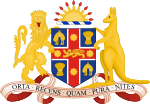The Local Court of New South Wales is the lowest court in the judicial hierarchy of the Australian state of New South Wales. Formerly known as the Court of Petty Sessions and the Magistrates Court, there are more than 160 branches across New South Wales where the Local Court has jurisdiction to deal with the majority of minor civil and criminal matters.
| Local Court of New South Wales | |
|---|---|
 | |
 James Barnet designed Bathurst Courthouse, completed in 1880, one of the sites for the Local Court. | |
| Jurisdiction | |
| Location | ~160 branches across New South Wales |
| Composition method | Vice-regal appointment upon Premier's nomination, following advice of the Attorney-General and Cabinet |
| Authorised by | Parliament of New South Wales via the Local Court Act 2007 (NSW) |
| Appeals to | |
| Judge term length | mandatory retirement by age of 75 |
| Website | localcourt.nsw.gov.au |
| Chief Magistrate | |
| Currently | Judge Peter Johnstone |
| Since | 2021 |
Matters are heard before a single magistrate sitting without a jury, addressed as "Your Honour" or "Sir" (but no longer "Your worship").[1] The Local Court has no jurisdiction for claims in equity.
On appeal, matters may be heard by the District Court of New South Wales including appeals against the sentence or conviction decided in the Local Court.[2]
The Chief Magistrate of the Local Court is Judge Peter Johnstone, former President of the NSW Children's Court, who was appointed in September 2021.[3] Judge Johnstone succeeded Judge Graeme Henson, appointed in 2006.[4]
History
editIn 1788, following the landing of the First Fleet and establishment of the Colony of New South Wales, the power and authority of the first criminal and civil courts in the Colony of New South Wales were vested by the Charter of Justice.[5][6]
The first Court of Petty Session's courthouse was constructed in 1821 at Windsor, 56 kilometres (35 mi) northwest of Sydney.[6]
Structure and jurisdiction
editThe Local Court of New South Wales hears civil matters of a monetary value of up to $100,000; mental health matters; family law and/or child care matters; adult criminal proceedings, including committal hearings, and summary prosecutions for summary offences (i.e., offences of a less serious nature) and indictable offences; licensing issues (as the Licensing Court); industrial matters; and mining matters.[7][8] In addition to this, the Local Court, via its Small Claims Division, hears claims for less than $10,000 and also hears applications for Apprehended Violence Orders (AVOs). The local court has limited jurisdiction under the Family Law Act 1975 (Cth) to hear and determine family law matters. The local court can deal with applications such as property settlements and residence orders.[9]
A magistrate can imprison offenders for no more than two years per sentence and no more than the maximum of five years for multiple sentences.
The Children's Court is another specialist court that deals with cases involving children, including criminal, education and care and protection cases. The Children's Court sits at the Local Court level of the NSW court hierarchy, but is not part of the Local Court, and is instead its own independent jurisdiction led by a President (who is a Judge of the District Court) and composed of Children's Magistrates (who are specially trained magistrates appointed from the Local Court bench by the Chief Magistrate of the Local Court, in consultation with the President of the Children's Court). The Children's Court is a closed court. While the media may attend proceedings, they may not publish any details that may identify any children or young people involved in court proceedings.
The Coroner's Court is another division within the Local Court that investigates violent or unnatural deaths, suspicious fires and/or explosions, but it cannot make orders to punish offenders. Coroners may, however, terminate their proceedings and pass on their findings onto state or federal Directors of Public Prosecutions for initiation of proceedings in another court at their discretion.
See also
editReferences
edit- ^ "Local Court Practice Note No. 1 of 2004: Form of Address in Court" (PDF). Local Court of New South Wales. Government of New South Wales.[permanent dead link]
- ^ "Appeals". District Court. Government of New South Wales. 6 June 2016. Retrieved 10 August 2016.
- ^ "Law Society of NSW welcomes new Chief Magistrate". September 2021.
- ^ Nedim, Ugur (6 November 2015). "Behind the Scenes: Downing Centre Magistrates". Downing Centre Court. Sydney Criminal Lawyers. Retrieved 9 August 2016.
- ^ Charter of Justice 2 April 1787 (UK)
- ^ a b "History". Local Courts New South Wales. Government of New South Wales. 10 June 2016. Retrieved 8 August 2016.
- ^ "Court Structure, Judges' Titles, and Order of Seniority" (PDF). The New South Wales Bar Association. September 2007. Archived from the original (PDF) on 21 March 2012.
- ^ Local Court Act 2007 (NSW)
- ^ "About us". Local Court. Government of New South Wales. 18 April 2016. Retrieved 8 August 2016.